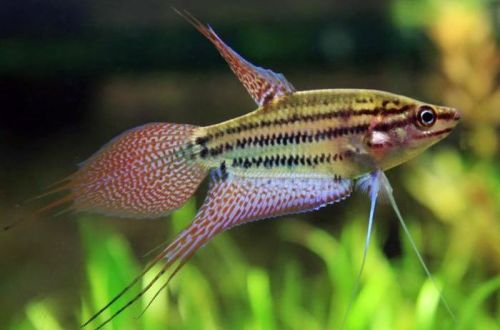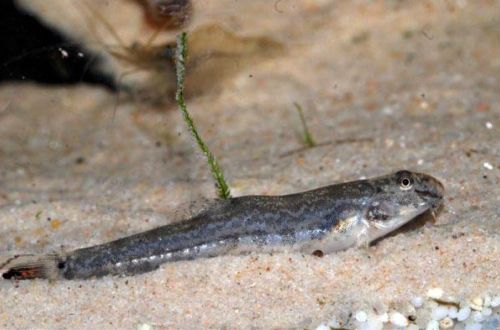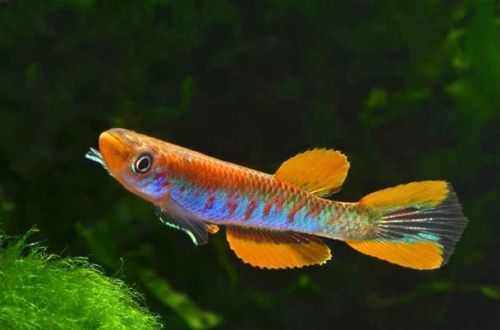
Gourami grumbling
Grumbling gourami, scientific name Trichopsis vittata, belongs to the Osphronemidae family. Can be considered an excellent candidate for almost any general freshwater aquarium. It is completely unpretentious, hardy, easy to keep and establish, and also has a curious ability to produce “croaking” sounds during the mating season.

Contents
Habitat
It is widely distributed in Southeast Asia on the territory of the modern states of Vietnam, Laos, Cambodia, Thailand, Malaysia and Indonesia. A wild population has also been introduced in Palm Beach County, Florida, USA. It lives in swampy reservoirs with dense vegetation in rather extreme conditions – stagnant water with a very low concentration of dissolved oxygen. It is also found in places flooded for agricultural use, such as rice fields.
Brief information:
- The volume of the aquarium – from 50 liters.
- Temperature – 22-25°C
- Value pH — 6.0–8.0
- Water hardness – soft to hard (5-25 dGH)
- Substrate type – any
- Lighting – subdued
- Brackish water – no
- Water movement – little or no
- The size of the fish is up to 7 cm.
- Meals – any
- Temperament – peaceful
- Content both alone and in pairs/groups
Description
Adults reach a length of about 7 cm. The color is predominantly gray or brownish with rows of dark horizontal stripes. Males, in comparison with females, have large bright fins of light purple color with burgundy speckles.
Food
They are unpretentious to the diet, the basis of which in a home aquarium can be any high-quality dry food (flakes, granules) from a well-known manufacturer.
Maintenance and care, arrangement of the aquarium
The optimal tank size for one or a pair of fish starts from 50 liters. The design uses dense thickets of rooted and clusters of floating plants with numerous shelters in the form of snags or decorative objects (wrecks, castles, etc.). Any substrate.
Aquarium equipment is configured based on the needs of the fish in a low level of illumination and the absence of internal current. The tank must be covered with a tight lid, thanks to which a warm, moist layer of air is formed above the surface of the water, which is necessary for the normal breathing of labyrinth fish. Gourami grumbling is not picky about the composition of the water and feels great in a wide range of pH and dGH values.
Behavior and Compatibility
A peaceful and sociable species, it goes well with other fish of similar size and temperament, and given its unpretentiousness to water conditions, the number of possible neighbors becomes very large.
Breeding / breeding
In the absence of other fish, spawning can be carried out in a common aquarium, otherwise it will be necessary to prepare a separate smaller tank, where sexually mature fish will be transplanted during the mating season.
It has been noted that spawning is stimulated by a gradual decrease in the water level to 10–15 cm in depth and an increase in temperature to 24–25°C. After a while, the females become noticeably rounder, and the males start building a nest of air bubbles among a cluster of floating plants. Then the courtship period begins. The male swims near the female, fluffing his fins and tail, sometimes you can hear “croaking” sounds, which also serve to attract potential partners. Gourami produces sounds with the help of special pectoral fin structures, similar to how the African catfish Synodontis veil does. A similar feature is reflected in the name of the species – “grunting”.
Spawning itself is accompanied by a kind of embrace, each time several eggs and a portion of the seed are released, in total the clutch can contain up to 200 eggs. Soon the female leaves the nest and is no longer interested in the fate of her offspring. The male behaves completely differently, he continues to stay near the nest, protecting it from other fish. This continues throughout the incubation period (24-48 hours) and the next few days, until the fry begin to swim freely. This is where his concern ends.
Fish diseases
The main cause of most diseases is unsuitable living conditions and poor-quality food. If the first symptoms are detected, you should check the water parameters (pH and dGH) and the presence of high concentrations of hazardous substances (ammonia, nitrites, nitrates, etc.), if necessary, bring the indicators back to normal and only then proceed with treatment. Read more about symptoms and treatments in the Aquarium Fish Diseases section.





